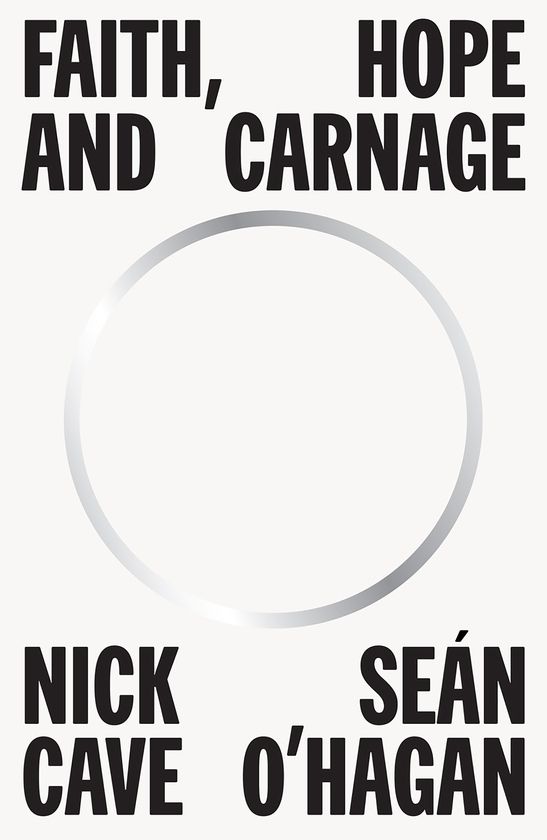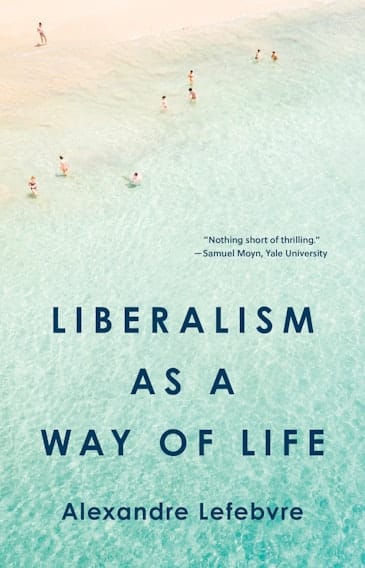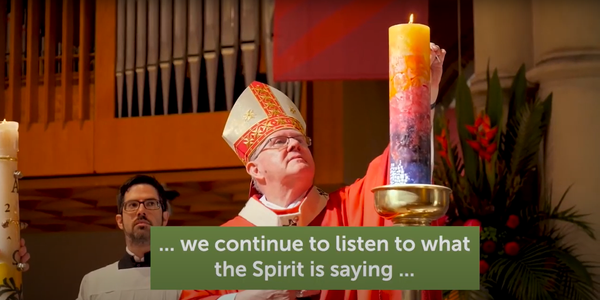Faith, Hope and Carnage // The crucified grief of Nick Cave
Nick Cave's articulation of God is much closer to orthodox Christianity than he realises, and more coherent than the God of many Christians.

Review: Faith, Hope and Carnage (2022) by Nick Cave and Sean O'Hagan.
- Søren Kierkegaard
NICK CAVE'S RELIGIOUS SENSIBILITIES ARE UNMISTAKEABLE. By this, I don’t simply mean that his songwriting and musings focus exclusively on those themes we associate with ‘religion’ in the narrow sense, although they often do. Rather they are unmistakable in that his worldview—and by extension his craft—is borne from an acknowledgment of transcendence: that behind the nagging ephemerality of our existence lies something greater; a type of unifying framework that gives form to the otherwise unintelligible melange of the good, bad, ugly, and soul-crushingly tragic, that life serves generously to each of us. His is a world of ‘spiritual yearning,’ whereby art and creativity flow from an inescapable attempt to quench an unrelenting ontological thirst.
None of this is to say that Cave simply harbours an intuition of there being ‘something more’ to our existence. It would be too neat an assertion to cast him as just another member—albeit of the celebrity class—of the fashionable ‘SBNR’ or ‘SBNA’ (Spiritual But Not Religious/Spiritual But Not Affiliated) club. Whilst he’s hesitant to call himself a ‘Christian’, he is undeniably fond of Jesus—so much so that he authored an introduction to Mark’s Gospel in 1998—and his thought betrays a remarkably astute understanding of the way in which the Christian tradition speaks of the human condition. In fact, his formative years included drawing artistic inspiration from Christian art such as Grünewald’s Crucifixion and the poetry St John of the Cross to help him make better sense of the nature of the soul.
All of this and more is on full display in his latest book, Faith, Hope and Carnage—the transcript of a series of interviews between Cave and Irish journalist Sean O’Hagan. If Cave’s body of work up to this point can be thought of as grand drama, fashioned with a kaleidoscopic cast of musical influences from Leonard Cohen to Bob Dylan to Nina Simone, together with a narrative arc filled with no shortage of Christian impulses (think here of 1988 song Mercy Seat), this book is something of a monologue through dialogue. In its 300 odd pages, Cave lays bare his deepest religious convictions with an endearing frankness. One finds nothing of the robust confidence of say a fresh out-of-the-font Pentecostal convert, or worse, the near boastful certainty of a trendy Catholic social-media apologist. Rather, Cave articulates his faith through the raw, if at times inchoate, ponderings of a man deeply fractured by the death of a child.
This isn’t to say that devotees of The Birthday Party, The Bad Seeds or Grinderman will be left wanting. There is enough surgical probing and prodding by O’Hagan on topics such as songwriting method, band dynamics, performing and ‘being on the road’, as well as stories of Cave’s upbringing and influences, to keep the purists satisfied.

To be sure though, those moments are but ornaments, and dull ones at that, in the greater plotline throughout: a sobering interrogation of human grief. And so it is the sudden death of Cave’s 15 year-old son Arthur in 2015 that hovers like the shadow of Gethsemane throughout the conversation; a third interlocutor never more than a moment away from the discussion.
In ruminating on the crippling grief of losing a loved one, Cave joins esteemed Christian company. In his Confessions, Augustine of Hippo—perhaps the first and arguably greatest of Christian existentialists—hides nothing of the inescapable sorrow caused by the sudden loss of a friend:
“My heart was clouded over with such grief, I saw death wherever I looked… I had become a great question to myself, and I asked my soul why it was sad and why it was so disquieted within me, and I had no answer to give myself.”
Decades before Augustine wrote his Confessions, another influential early Christian writer, Gregory of Nyssa, expressed the “ungovernable violence” brought upon by the death of his older brother Basil. Yet Gregory’s terrible grief over Basil was just the beginning. He would be thrust further and more forcefully into its grip by the loss of his sister and teacher Macrina not long after, an event that forced him to concede that his rationality had been overcome by passion; his grief had rendered him all but incapacitated.
Cave similarly hides nothing of the way in which Arthur’s death paralysed him and wife Susie. They were “obliterated” and entered a space of “absolute annihilation.” A pure form of carnage. Consider Cave’s description of its effects:
“I could feel it literally rushing through my body and bursting out the ends of my fingers. When I was alone with my thoughts, there was an almost overwhelming physical feeling coursing through me. I have never felt anything like it. It was mental torment, of course, but also physical, deeply physical, a kind of annihilation of the self—an interior screaming.”
To be sure, grief of this magnitude, for Cave, was more than just his tortured mental state and its physical effects. It ushered in an entirely new condition, which rendered all that had gone before “largely irrelevant” and forever cast everything after in light of that event. Grief had become a type of hermeneutical lens framing Cave’s entire picture of reality.
Despite the intensity of this grief, its paralysis eventually gave way to something greater: a renewed spiritual and artistic vitality. In terms of his religious sensibilities, it crystallised his intuitions about what it means to be human, enabling him to decidedly break free from any belief that rational truth is the “only game in town” and confirming that relationality, both to others and to nature itself, are part of the human fabric. Rationality’s limits also make clear that poetic and metaphorical truth have their place, through them one can glimpse the eternal, and without them, life dangles helplessly over an abyss of nothingness.
Yet Cave’s musings about the divine are not those of the disinterested God of the deists but rather a God in attendance, present and animating all of creation. Through love, the divine and temporal are united. Cave’s articulation of God is much closer to classical orthodox Christianity then he probably realises and profoundly more coherent than the idol many professed ‘Christians’ claim to worship.
Where does all of this leave the spiritually incredulous though? The atheists and secularists among us? Cave rightfully notes that they’re buying a fundamentally broken product. Identity politics, woke-ism and the general hardening of political differences into quasi-religious movements are symptomatic of a deeper yearning for meaning, clear evidence of the impoverished nature of the disenchanted world.
The ‘buffered self’ of modernity lacks a compelling argument for our need for forgiveness, mercy, compassion, beyond their social utility. But is that all they are—useful? And does Cave’s advocacy for the belief in the transcendent rely purely on its ability to help us get along? Its ability to foster community and ground values while staving off a brutish dog-eat-dog existence? One could perhaps make that argument if Cave’s artistic expression wasn’t so densely laced with themes of divinity, suffering, faith, love, hope and death throughout, and if he didn’t say things like the following:
“[S]ince when did belief in God have anything to do with logic? For me personally, it is the unreasonableness of the notion, its counterfactual aspect that makes the experience of belief so compelling. I find that leaning into these intimations of the divine, that for me do exist, as subtle, softly spoken and momentary as they may be, expands my relationship with the world.”
Again, Cave isn’t making the argument for transcendence because it’s irrefutable, but rather that paradoxically, there is a compelling rationality of irrationality at the centre of religious belief. This can be seen in the antinomy of belief and doubt, which he sees as less a bug and more a feature of divinity's calling: “To me, the great gift of God is that He provides us with the space to doubt. For me at least, doubt becomes the energy of belief.” The recognition of the interdependence of these two poles was made also by one Joseph Cardinal Ratzinger in 1968 in his Introduction to Christianity. Ratzinger noted that it is only through this “unceasing rivalry” between belief and doubt—what he called the basic pattern of man’s destiny—that one is able to find any sort of existential terminus.

Yet beyond its service to metaphysical clarity, grief’s other gift to Cave was in relation to his craft. This shouldn’t be surprising. Grief’s ability to inspire art of the most sublime and captivating type is well known. Think of Giotto’s Lamentation fresco or, perhaps more famously, Michelangelo’s Pieta, or basically anything from the brush of Edvard Munch. As devastating as it was to lose Arthur, Cave’s renewed artmaking in light of that event is nothing short of a recapitulation, or to use even stronger Christian imagery, a resurrection. In fact, Cave uses a striking, and at times explicit, Christian grammar to speak of the production of the album Ghosteen, the first album since Arthur’s death and according to many, the Bad Seeds’ finest work.
The album as a whole is a beautiful yet haunting ode to Arthur. Cave speaks of it as a “metaphysical conversation with Arthur”, a type of “prayer.” Its importance to him, beyond a type of spiritual union with his son, was the ability to write through the trauma. As grief enlarged his heart, and filled it with compassion, tenderness and love, Cave was able again to see fragments of light through the darkness, to peel back the colourlessness that had enveloped him on that fateful evening and learn to make art again and anew. Like Kierkegaard, Cave’s grief, whilst ever present, is now furnished with his own tapestries and in Ghosteen, beauty and suffering come together to give birth to something wondrous and awe inspiring, even supernatural.
What is the Christian story of salvation if not this? A Father giving his Son, the Son giving his life, and in the deepest despair of that death and its devastation, the promise of new life, of rebirth, of one day eternal bliss—
And I love you, and I love you, and I love you
Peace will come, and peace will come, and peace will come in time
Time will come, and time will come, a time will come for us
—Spinning Song




